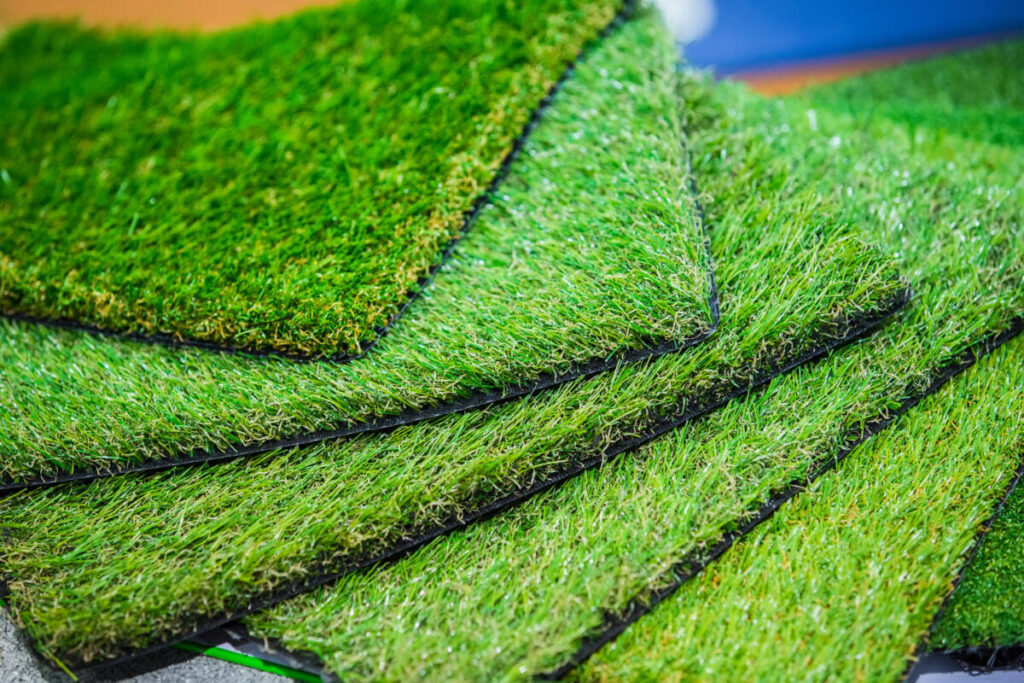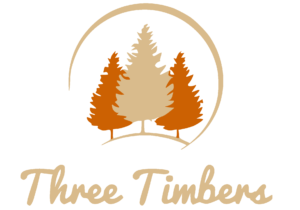Are you tired of constantly mowing, watering, and maintaining your lawn? Trying turning to artificial grass.
The best artificial grass is a low-yard maintenance, aesthetically pleasing alternative that has grown in popularity. With various types of artificial grass available, it can be challenging to choose the right one for your outdoor space. This blog post will guide you through the top 5 best artificial grass options for different purposes, key factors to consider when selecting artificial grass, tips for a successful installation, and how to maintain your best artificial grass for longevity. Say goodbye to endless lawn care and hello to a perfect, green oasis!
Key Takeaways
This guide provides an overview of the top 5 artificial grass options for various purposes, key factors to consider, and essential tips for successful installation.
Regular cleaning, stain and odor management, as well as periodic grooming are necessary to maintain your artificial grass’ longevity and pristine appearance.
Ground preparation steps such as removing existing soil/grass & compacting the area should be taken into consideration prior to installation. Seaming & edging techniques can help ensure a professional look.
Top 5 Artificial Grass Options for Various Purposes
Knowing which type of artificial grass is suitable for your needs can be a game-changer. Whether you want to create an ideal landscape, provide a safe space for your pets, or build a sports field, there is an artificial grass option meant for you. We shall discuss the top 5 artificial grass options, including:
Landscaping Artificial Grass
Pet-Friendly Artificial Grass
Sports-Grade Artificial Grass
Putting Green Artificial Grass
Multipurpose Artificial Grass
1. Landscaping Artificial Grass
Landscaping artificial grass, also known as artificial landscape grass, mirrors the appearance of natural turf, offering a low-maintenance and visually appealing option for homeowners. The main characteristics to consider when selecting the best landscaping artificial grass include a high face weight and lengthy pile height. Some popular brands in the landscaping artificial grass market are SYNLawn, XGrass, EasyTurf, MegaGrass, and AstroTurf. Artificial grass is renowned for its durability, with a lifespan of up to 25 years, outlasting natural turf that requires frequent maintenance.
Landscaping artificial grass notably aids in water conservation, especially in arid climates. It eliminates the need for irrigation, saving both water and money on water bills. Additionally, artificial grass doesn’t require the use of pesticides or fertilizers, making it a more eco-friendly option compared to natural turf.
2. Pet-Friendly Artificial Grass
Pet-friendly artificial grass boasts durability, easy cleaning, and non-toxic materials, ensuring a safe and comfortable surface for pets. This type of synthetic grass is made from safe, non-toxic polyethylene and has a face weight of 60 ounces, providing a sturdy surface that can withstand pet activity. Our best artificial grass products, including realistic artificial grass like PetGrow synthetic artificial grass and other fake grass products, cater to the needs of pet owners, offering a reliable solution for their outdoor spaces. With installed synthetic grass, pet owners can enjoy a low-maintenance and visually appealing lawn.
For pet-friendly artificial grass, selecting a cooling infill, cooling infill is recommended. This helps to keep the surface temperature comfortable for your pets, even during hot summer days.
With pet-friendly artificial grass, you can let your furry friends run and play without worrying about them damaging your lawn or causing muddy patches.
3. Sports-Grade Artificial Grass
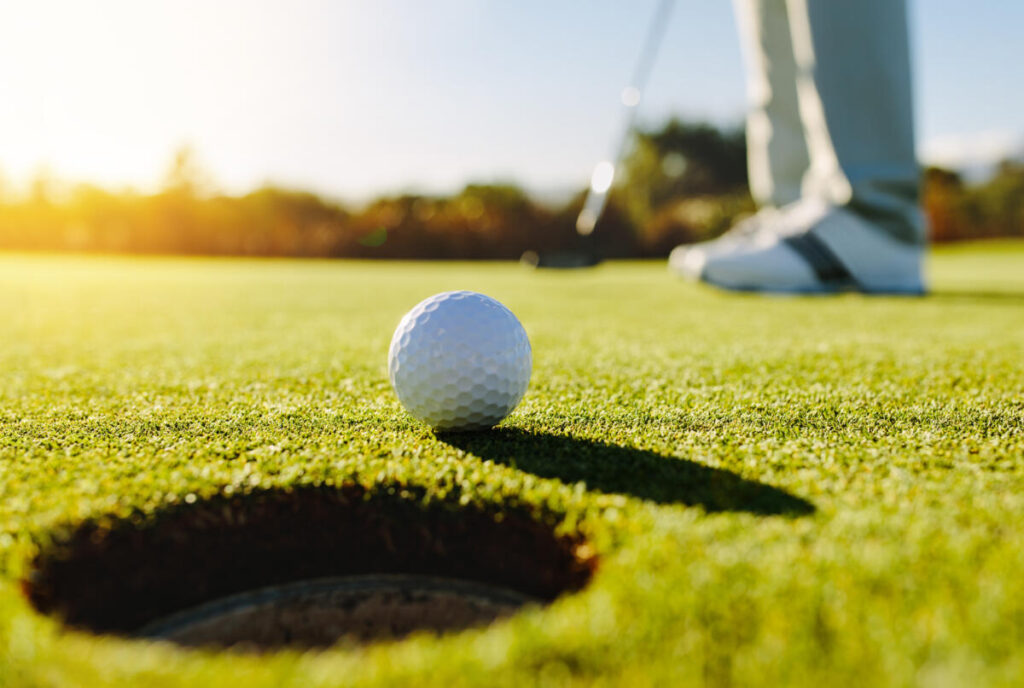
Sports-grade artificial grass, also known as synthetic turf, caters specifically to sports fields and athletic facilities. This type of artificial grass offers optimal traction, reduces the risk of injury, and is cleat-friendly. Made from polyethylene, sports-grade artificial grass is not only durable but also comes with a 5-year warranty. As a member of the Synthetic Turf Council, we ensure the highest quality standards in our products.
As sports-grade high-quality artificial grass is designed to withstand heavy foot traffic and provide a safe playing surface, it is an ideal choice for sports fields, playgrounds, and other high-traffic areas. Additionally, the material is UV stable, ensuring that the colors remain vibrant even after prolonged exposure to sunlight. Sunvilla artificial grass is a great example of this type of product.
4. Putting Green Artificial Grass
Putting green artificial grass, also known as putting greens, aims to offer golf enthusiasts a lifelike playing surface that closely resembles real grass. This type of artificial grass is composed of a combination of materials such as nylon, polypropylene, and polyethylene, creating a surface that replicates the properties of a genuine golf course. The stimp speed, or stimp rating, of artificial grass can be adjusted to replicate various green conditions, allowing golfers to adapt to different courses.
Installing putting green artificial grass offers numerous benefits:
Requires very little maintenance compared to natural grass
UV stability ensures vibrant color even in direct sunlight
Heat and frost resistance make it suitable for various weather conditions
5. Multipurpose Artificial Grass
Multipurpose artificial grass showcases high versatility, suitable for various applications such as playgrounds, rooftops, and patios. It is designed for heavy traffic and provides a safe and durable surface. Composed of high-quality materials, multipurpose artificial grass is UV stable, heat resistant, and frost resistant, making it an ideal choice for outdoor spaces.
Playsafe Turf Rolls is an example of multipurpose artificial grass designed for playgrounds, available by the square yard. It boasts the following features:
Fall height rating of 2′ – 8′
Crafted from non-toxic polyethylene fiber
40oz face weight
10-year warranty
Playsafe Turf Rolls is not only durable but also reasonably priced.
Key Factors to Consider When Choosing Artificial Grass
Choosing the right artificial grass depends on several key factors, such as material quality, pile height and density, drainage system, and installation and maintenance requirements.
We will delve into these factors, assisting you in choosing the ideal artificial grass.
Material Quality
The durability and longevity of artificial grass heavily rely on its material quality. Artificial grass is typically made from polyethylene, polypropylene, or nylon. Each material has its advantages and disadvantages in terms of appearance, texture, and lifespan. For example, polypropylene has the shortest lifespan but is the most economical, while nylon is the sturdiest material and is used in applications that require superior strength.
When selecting artificial grass, it is important to consider factors such as water conservation, carbon emissions, and the impact on wildlife habitat, as some types of artificial grass are more eco-friendly than others. Furthermore, the production of artificial grass can lead to landfill waste and pollution. Thus, it is recommended to choose materials that are more sustainable and have a lower environmental impact.
Pile Height and Density
The appearance and texture of artificial grass are significantly affected by their pile height and density. The pile height refers to the length of the fibers or blades of grass, which can range from 10mm to 200mm. A longer pile height can give the grass a more realistic and natural look, providing a lush and full appearance. However, a shorter pile height may provide a firmer and more compact feel. To achieve a natural appearance, it is recommended that the pile height of artificial grass be between 30-38mm.
Density, on the other hand, is the number of stitches or blades of grass per square meter, and it is an indicator of the woven grass’s durability. A denser grass is more resilient to wear and tear and can handle more foot traffic. Additionally, it provides better resilience and can withstand heavy use. In terms of comfort, higher density can result in a softer and more comfortable surface. Thus, density is an essential factor in both the durability and comfort of artificial grass.
Drainage System
Artificial grass necessitates an efficient drainage system, ensuring water can flow through and prevent standing water or mold growth. The drainage system for artificial turf includes:
The backing of artificial turf is designed to be highly porous, allowing water to percolate through and drain through the base layer.
Some artificial turf may have drainage holes to facilitate water drainage.
Subsurface grids or drainage grids can be installed beneath the turf to collect and redirect water to a predetermined exit drain, preventing the accumulation of water that can lead to mold growth.
There are several types of drainage systems available for artificial grass, including:
Sub-base drainage system
Air drain system
Drainage mats
Artificial turf with drainage holes
Choosing the right drainage system for your artificial grass will depend on your specific needs, such as the amount of rainfall in your area and the slope of your property.
Installation and Maintenance Requirements
Comprehending the installation and maintenance needs of artificial grass is key to selecting a product that fits your requirements and budget. The installation steps for artificial grass typically include:
Pre-installation
Preparing the sub-base
Laying out the turf
Cutting the turf
Seaming the turf
Securing the edges
Infilling the turf
Brushing and grooming the turf
While professional installation is not a requirement, it can ensure an aesthetically pleasing result and accurate excavation.
Artificial grass requires regular maintenance to ensure its longevity. This includes activities such as weekly watering and biweekly cross-brushing. The frequency of top-up infill and grooming may vary depending on the usage of the artificial turf. By adhering to the manufacturer’s instructions for specific care and maintenance recommendations, you can ensure that your artificial grass remains in top condition for years to come.
Tips for a Successful Artificial Grass Installation
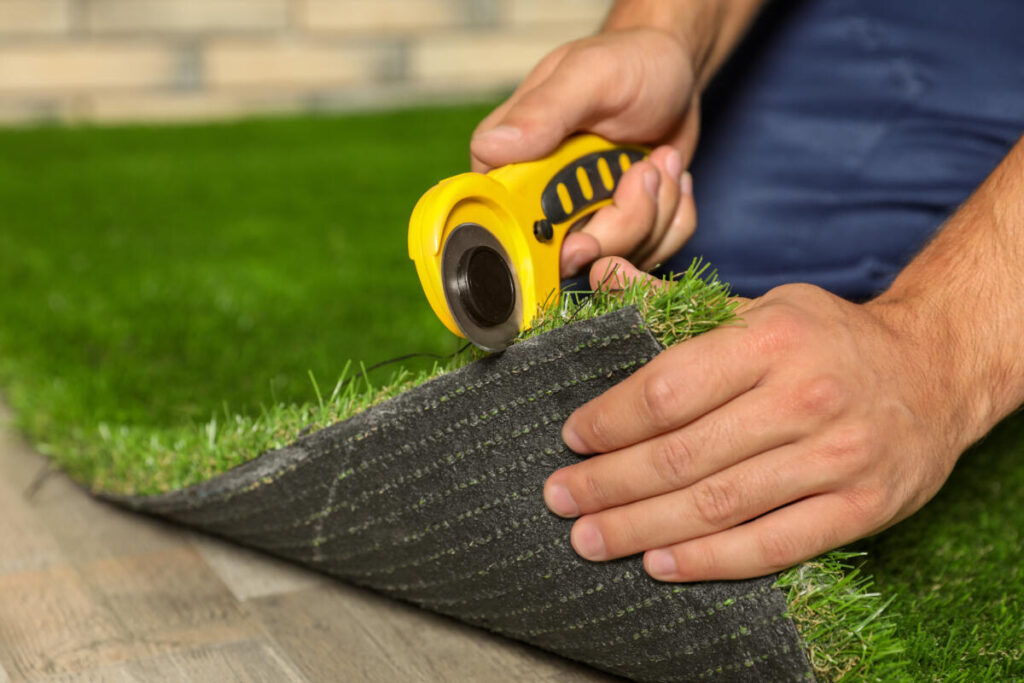
Proper installation is key to ensure the longevity and performance of your artificial grass. In this part, we’ll share crucial tips to ensure a successful artificial grass installation, covering ground preparation, seaming and edging techniques, and infill selection.
Ground Preparation
Ground preparation is indispensable for the installation of artificial grass, ensuring a smooth and stable surface for the turf to be laid on. The steps to prepare the ground for artificial grass installation include:
Removing existing natural grass and 2-3 inches of soil
Applying weed killer
Employing a weed barrier cloth (optional)
Excavating the area
Flattening the ground
Lightly watering and compacting the area
Installing the artificial grass on the prepared ground.
When preparing uneven ground for artificial grass installation, follow these steps:
Level the ground to create a smooth surface.
Compact the ground to ensure stability.
Install a weed barrier to prevent weed growth.
Add a base material, such as crushed rock or decomposed granite, to provide a solid foundation.
Finally, install the artificial grass on top of the prepared ground.
Proper ground preparation is essential to ensure that your artificial grass will have a stable foundation, preventing issues such as shifting or sinking over time.
Seaming and Edging Techniques
For a professional-looking installation, effective seaming and edging techniques are vital, with proper joining of turf pieces and securing of edges. To join multiple pieces of artificial grass seamlessly, follow these steps:
Unroll the two pieces, ensuring that the pile runs in the same direction.
Fold over each piece approximately 300mm.
Utilize seaming tape and glue to secure the seams.
Press the turf to the seam tape by hand and push the two pieces together firmly.
To secure the edges of artificial grass and prevent lifting, rust-resistant nails or U-pins spaced closely together around the perimeter can be employed. Alternatively, galvanized U-pins or turf U-staples can be utilized.
Additionally, decking screws inserted at a 45-degree angle can be used to secure the grass to edging, ensuring a professional finish.
Infill Selection
The performance and appearance of artificial grass can be influenced by the selection of infill. The choice of infill material depends on the type of artificial grass, the climate, and the amount of traffic the grass will experience. Some common types of infill for artificial grass include:
Silica sand
Crumb rubber
Acrylic sand
Zeofill
Each infill material has its advantages and disadvantages. Here are some examples:
Silica sand: a natural material that offers blade protection and prevents matting, but does not provide cushioning effects when not combined with other infill types.
Rubber granules: provide a softer surface, shock absorption, and natural ball behavior.
T°Cool’s Evaporative Cooling Infill: can help reduce the surface temperature of the turf through evaporative cooling, making it more comfortable for use in hot climates.
How to Maintain Your Artificial Grass for Longevity
Maintaining your artificial grass is crucial to ensure its longevity and pristine appearance. We will discuss maintaining the freshness and cleanliness of your artificial grass through regular cleaning, stain and odor management, and periodic grooming.
Regular Cleaning
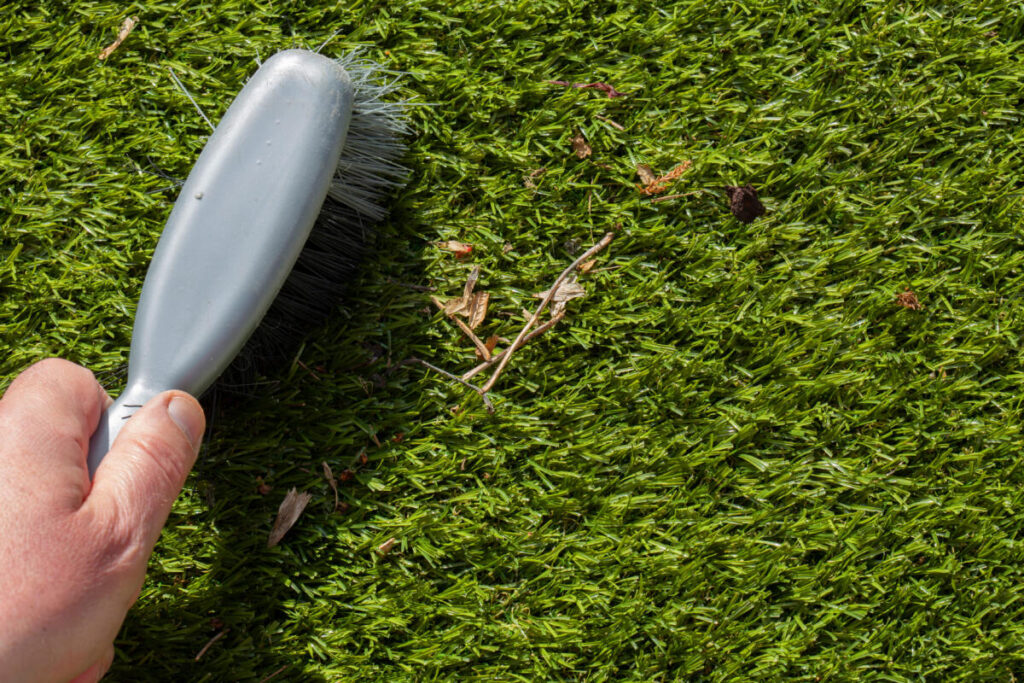
To retain the appearance and quality of artificial grass, regular cleaning is vital. Some recommended cleaning tools for artificial grass include:
Power brush
Stiff bristle broom
Leaf blower
Rubber rake
Enzyme cleaner
Garden hose
It is suggested to clean artificial grass at least once a month to maintain its appearance. If your yard is heavily utilized or is often impacted by dust and debris, it is recommended to rinse it once a week.
In addition to regular cleaning, it is important to inspect the entire area of artificial grass on a regular basis, at least every week or two, to identify and address any issues or damage. By following a maintenance schedule that includes activities such as weekly watering and biweekly cross-brushing, you can ensure the longevity of your artificial grass.
Dealing with Stains and Odors
Proper cleaning solutions and techniques can tackle stains and odors, ensuring that your artificial grass remains fresh and clean. The most effective cleaning solutions for removing stains from artificial grass include:
A 3% solution of ammonia in water
Homemade solutions such as baking soda and vinegar
A mild soap solution
A mixture of equal parts apple cider vinegar and baking soda
When dealing with pet odors, it is important to use diluted vinegar and water or commercial enzyme-based products to eliminate the smell. By addressing stains and odors promptly, you can maintain the pristine appearance and freshness of your artificial grass.
Periodic Grooming
Periodic grooming, including brushing or power brooming, aids in maintaining the upright position of artificial grass fibers and averting matting. It is recommended that artificial grass be groomed lightly every three to four weeks in order to maintain the blades standing upright.
Regular grooming is essential for maintaining the appearance and performance of your artificial grass. By keeping the grass free from debris and facilitating proper drainage, grooming can prevent the accumulation of allergens and other undesirable substances, ensuring the longevity and aesthetic appeal of your artificial grass.
Summary
In conclusion, artificial grass is an excellent low-maintenance alternative to natural grass, offering various options for different purposes such as landscaping, pet-friendly areas, sports fields, putting greens, and more. By understanding the key factors to consider when choosing artificial grass, following tips for a successful installation, and maintaining your artificial grass with regular cleaning, stain and odor management, and periodic grooming, you can enjoy a perfect green oasis in your outdoor space for years to come.
Frequently Asked Questions
What type of artificial grass is best?
Nylon is the most durable fiber used for artificial turf, but Polypropylene is better for outdoors, as it won’t fade in direct sunlight and is softer and less abrasive.
Which artificial grass is the most realistic?
ForeverLawn’s Select line of synthetic grass is the most realistic, with its tan thatch that mimics the construction of natural grass.
What thickness of artificial grass is best?
For best results, an artificial grass thickness of between 20-40mm is recommended. This is the most common height range for artificial turf.
What do you put under fake grass?
For a successful artificial grass installation, it is essential to use a geo-textile paper/mesh weed barrier, crushed aggregate/gravel, weed membrane, Astro-Cushion, granite dust, sub-base and artificial grass infill.
What are the top 5 artificial grass options for various purposes?
The top five artificial grass options for various purposes are Landscaping, Pet-Friendly, Sports-Grade, Putting Green, and Multipurpose Artificial Grass.

